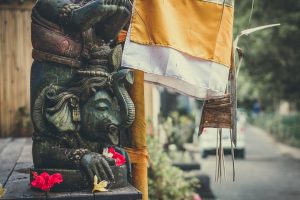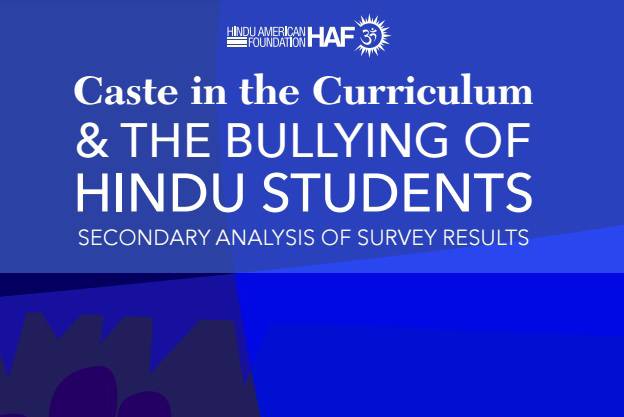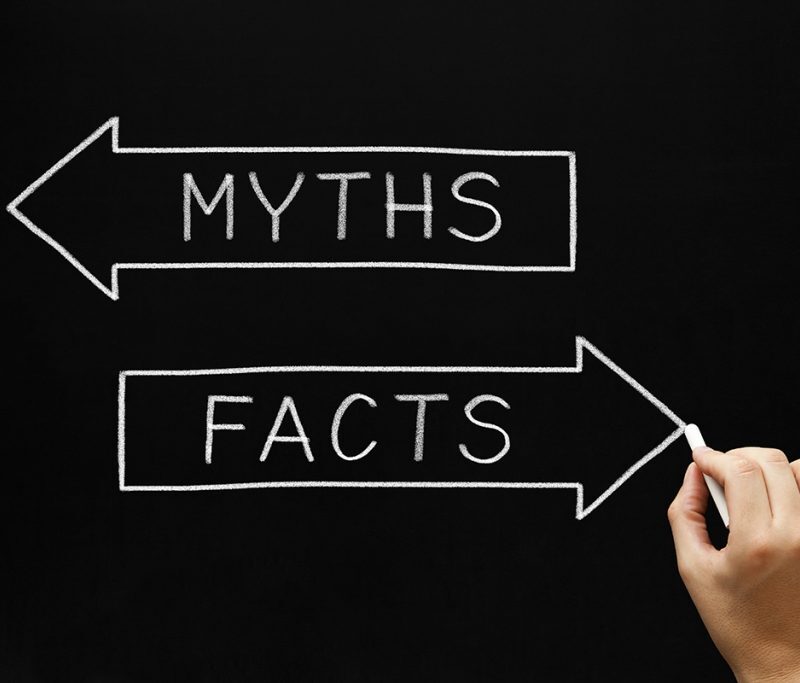

The arts and Hinduism are often two faces of the same coin. Dance forms, such as Bharatanatyam, are performed to evoke spirituality, to visually represent the messages entailed within the Vedas, the primary body of Hindu scriptures, and other texts. Song forms, such as Carnatic music, embody harmony, both within oneself and with the environment; and visual arts, such as those found lining the walls of temples, symbolize various aspects of God, their omnipresence and omnipotence touching every cleft of the universe.
For many Hindu American students, their respective activity, be it visual art or dance, provides a direct connection to Hinduism. For them, art is their prayer, their bhajan (devotional song), their mantra (sacred hymn). It is their safe haven and their way of reaching God.
…
Sophomore Ishani Singh was only six years old when she fell in love with the South Indian dance form Bharatnatyam. Dazzled by its symmetrical choreography, its ability to incorporate both power and emotion in a single performance, and its emphasis on grace formed out of order and harmony, Singh decided, along with her older sister, to attend dance classes at the Shri Krupa Dance Company. There, she was taught how to use hand gestures called mudras to tell a dancer’s story. Representing anything from everyday objects and animals to religious figures and symbols, these mudras served to not only add depth to a dance routine, but to also evoke emotions in the audience. Similarly, drishti bhedas (eye movements) helped to convey meaning and natya vardhini (facial expressions) helped to capture the audience’s attention.

Ishani Singh dances with deep emotion at her Bharatnatyam performance. Photo used with permission of Singh.
For Singh, combining all these elements into one presentation was a difficult endeavor, for it required a large amount of attention to detail as well as practice. Given this, as a young elementary schooler, whose impatience outshined all her other traits, Singh soon began to lose her passion for dance.
“I was very bad when I started, and I had no emotional or spiritual connection [to] what I was doing,” Singh said. “A lot of the times, I just wanted to stop because I felt like I was doing it for my parent’s sake.”
Things began to change, however, when Singh began her fifth year of dance.
“Around year five, something clicked, and I really started enjoying what I was doing,” Singh said. “I would hear a lot of comments about how I wasn’t as good as the other dancers in my class, and I guess that’s what really motivated me to work harder. Soon enough, then, dance became about me.”
Sophomore Sahana Prasanna had a slightly different start to her religious activity, Carnatic music, which is a form of South Indian classical song. Born to a family with a deep Hindu practice, Prasanna was forced by her mother to attend singing classes in order to stay in touch with her Indian roots.
As one might expect, this was not well received by the then-six year old elementary schooler, who wished to spend her time playing outside instead of practicing in her bedroom. Prasanna’s sentiment regarding Carnatic music would remain the same until middle school, when she switched teachers.

Sahana Prasanna enthusiastically performs a Carnatic song at her concert. Photo used by permission of Prasanna.
“At first, I hated it. I hated practicing,” Prasanna said. “But in 6th or 7th grade, I started learning from another teacher, and he changed my life. He helped me discover what I liked about music so that I could actually connect with it.”
Senior Gokul Pillai, also a Carnatic singer, claims that although his love for singing is undying, he has never been able to truly form a connection with the activity. In fact, the only reason he continues to attend singing classes today is because his parents want him to.
“[Carnatic music] is something I appreciate, but it’s also something that I don’t necessarily feel inclined toward,” Pillai said. “But I still do appreciate all the things I’ve learned from it, how it allows me to stay connected to my culture.”
For Pillai, Carnatic music serves as a crossroad between his current identity and his Indian identity. But for Prasanna and Ishani, their activities are much more significant as they serve as a direct link between their Hindu faith and their morality.
Singh, in particular, expresses that only through Bharatnatynam has she been able to increase her knowledge about Hinduism, the lore, the Deities, the practices. Said to be created by Lord Shiva, one of the three Supreme Beings in Hinduism, Bharatnatyam encompasses several South Indian religious themes and spiritual ideas, particularly those centered around Shaivism. As such, Singh admits that if it weren’t for dancing, she perhaps wouldn’t have been the devout Hindu that she is today.
“When I was younger, I didn’t pay attention to any of the stories or the festivals,” Singh said. “I kinda just did it as my parents told me to, and now I feel like I can understand what I’m doing and appreciate it. I would definitely consider myself to be an active Hindu because of dance.”
Prasanna echoes a similar sentiment, stating that Carnatic music has strengthened her faith in Hinduism in a way her parent’s teachings never could.
“Carnatic music is my spiritual connection to Hinduism,” Prasanna said. “Without it, I never would’ve been interested in all the stories. In fact, I’ve learned so many Hindu tales though music itself and it has really [resonated] with me.”

Gokul Pillai sings a Carnatic song at one of his concerts. Photo used by permission of Pillai.
On the opposite side of the spectrum lies Pillai, who, despite knowing the contents of several Hindu scriptures, feels rather indifferent towards the religion itself. For him, Carnatic music is simply another genre of song – nothing more and nothing less.
“My favorite part about [Carnatic music] is the actual singing, not the part about having to learn all the meanings of songs and performing at a bunch of concerts and learning lessons,” Pillai said. “It’s just not that rewarding to me.”
This, in combination with his already shaky beliefs regarding the validity of religion, is why Pillai claims that his faith in Hinduism hasn’t strengthened over the years. If anything, Pillai states, Carnatic music has only brought him a little closer to his cultural origins.
This is not to say that Pillai doesn’t recognize the immense potential of religious activities. He understands that while Carnatic music and other such activities may not hold much meaning to him, they certainly do for other individuals, such as Singh and Prasanna.
As a matter of fact, Singh comments that all people, whether they are agnostic or not, should give Bharatnatyam a try. In her opinion, the perseverance, the discipline, the grace that it teaches is applicable to all people, not just Hindus. She especially implores high school students, those about to enter the heat and rush of standardized testing and extracurriculars, to consider this art form, as it’s taught her more about life than any other activity.
“I would recommend this activity to others especially since we’re high schoolers about to enter SATs and ACTs,” Singh said. “Dance is the only thing that keeps me grounded and shows me that there’s more to life than studies. There is religion, there is faith, there is value. And dance allows me to touch all those aspects.”








































